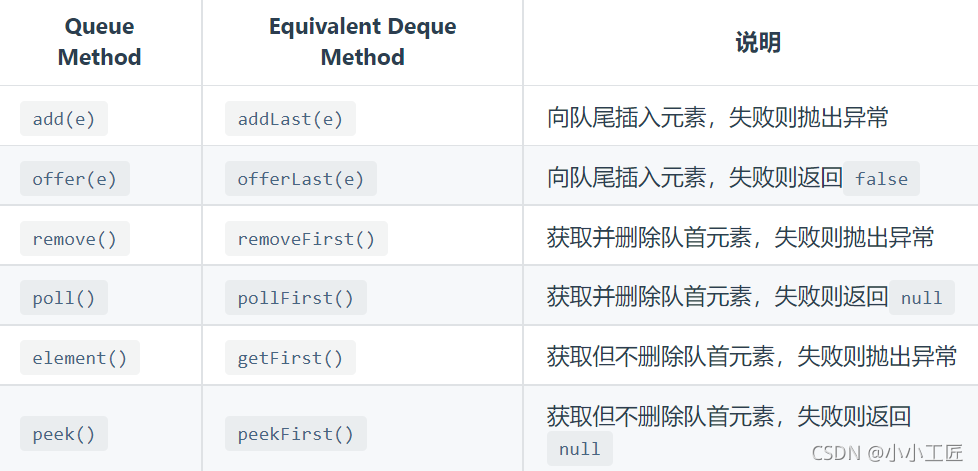文章目录

Pre
概述
Java中有Stack类,却没有叫做Queue的类,它是个接口的名字。当需要使用栈时,Java已不推荐使用Stack,而是推荐使用更高效的ArrayDeque;
既然Queue只是一个接口,当需要使用队列时也就首选ArrayDeque了,次选LinkedList。

Queue

Queue接口继承自Collection接口,除了最基本的Collection的方法之外,它还支持额外的insertion, extraction和inspection操作。
这里有两组格式,共6个方法,
- 一组是抛出异常的实现;
- 另外一组是返回值的实现(没有则返回null)。
| – | 抛出异常的方法 | 带有返回值的方法 |
|---|---|---|
| Insert | add(e) | offer(e) |
| Remove | remove | poll() |
| Examine | element() | peek |
Deque

-
Deque是"double ended queue", 表示双向的队列,英文读作"deck".
-
Deque 继承自 Queue接口,除了支持Queue的方法之外,还支持insert, remove和examine操作
-
由于Deque是双向的,所以可以对队列的头和尾都进行操作 . 同时也支持两组格式,一组是抛出异常的实现;另外一组是返回值的实现(没有则返回null)。共12个方法如下:

-
当把
Deque当做FIFO的queue来使用时,元素是从deque的尾部添加,从头部进行删除的; 所以deque的部分方法是和queue是等同的。如下
-
-
Deque的含义是“double ended queue”,即双端队列,它既可以当作栈使用,也可以当作队列使用。下表列出了Deque与Queue相对应的接

-
Deque与Stack对应的接口如下:

上面两个表共定义了Deque的12个接口。
添加,删除,取值都有两套接口,它们功能相同,区别是对失败情况的处理不同。
一组接口遇到失败就会抛出异常
另一组遇到失败会返回特殊值(false或null)。
除非某种实现对容量有限制,大多数情况下,添加操作是不会失败的。虽然Deque的接口有12个之多,但无非就是对容器的两端进行操作,或添加,或删除,或查看。


一览
ArrayDeque和LinkedList是Deque的两个通用实现,由于官方更推荐使用AarryDeque用作栈和队列,着重讲解ArrayDeque的具体实现。
-
从名字可以看出ArrayDeque底层通过数组实现,为了满足可以同时在数组两端插入或删除元素的需求,该数组还必须是循环的,即循环数组(circular array),也就是说数组的任何一点都可能被看作起点或者终点。
-
ArrayDeque是非线程安全的(not thread-safe),当多个线程同时使用的时候,需要手动同步;
-
ArrayDeque不允许放入null元素

上图中我们看到,head指向首端第一个有效元素,tail指向尾端第一个可以插入元素的空位。因为是循环数组,所以head不一定总等于0,tail也不一定总是比head大.
构造函数

/**
* Constructs an empty array deque with an initial capacity
* sufficient to hold 16 elements.
*/
public ArrayDeque() {
elements = new Object[16];
}
/**
* Constructs an empty array deque with an initial capacity
* sufficient to hold the specified number of elements.
*
* @param numElements lower bound on initial capacity of the deque
*/
public ArrayDeque(int numElements) {
allocateElements(numElements);
}
/**
* Constructs a deque containing the elements of the specified
* collection, in the order they are returned by the collection's
* iterator. (The first element returned by the collection's
* iterator becomes the first element, or <i>front</i> of the
* deque.)
*
* @param c the collection whose elements are to be placed into the deque
* @throws NullPointerException if the specified collection is null
*/
public ArrayDeque(Collection<? extends E> c) {
allocateElements(c.size());
addAll(c);
}
/**
* Allocates empty array to hold the given number of elements.
*
* @param numElements the number of elements to hold
*/
private void allocateElements(int numElements) {
elements = new Object[calculateSize(numElements)];
}
/**
* The minimum capacity that we'll use for a newly created deque.
* Must be a power of 2.
*/
private static final int MIN_INITIAL_CAPACITY = 8;
// ****** Array allocation and resizing utilities ******
private static int calculateSize(int numElements) {
int initialCapacity = MIN_INITIAL_CAPACITY;
// Find the best power of two to hold elements.
// Tests "<=" because arrays aren't kept full.
if (numElements >= initialCapacity) {
initialCapacity = numElements;
initialCapacity |= (initialCapacity >>> 1);
initialCapacity |= (initialCapacity >>> 2);
initialCapacity |= (initialCapacity >>> 4);
initialCapacity |= (initialCapacity >>> 8);
initialCapacity |= (initialCapacity >>> 16);
initialCapacity++;
if (initialCapacity < 0) // Too many elements, must back off
initialCapacity >>>= 1;// Good luck allocating 2 ^ 30 elements
}
return initialCapacity;
}
三个构造函数
- 申请默认大小为16的数组
- 提供需要空间大小的有参构造器:利用allocateElements申请空间
- 利用现有集合的有参构造器:同样利用allocateElements申请空间,再将现有集合中的元素拷贝到数组中
allocateElements(int numElements) :数组最小空间为8, 如果需要空间小于8,则申请数组大小为8,如果需要空间大于等于8,进行一定的容量扩大,而不只是提供需要数量的空间,防止下一次操作时又要进行扩容
属性

ArrayDeque提供了两个变量来操作数组:head 、 tail.
-
head指向队列的头,tail指向队列尾的下一个位置,队列满的条件就是head == tail.
-
扩容操作的执行时机:每次在向队列中添加元素以后,不论是在头部还是在尾部添加。
-
扩容策略:空间是原空间的两倍大,将原来数组中元素拷贝到新数组中,因为是循环队列,可能出现head在tail后面的情况,拷贝到新数组时,从head指向开始拷贝,直到tail,也就是说,拷贝完成后,head指向新数组起始位置,tail指向最后一个元素的下一个位置。
方法
addFirst()
/**
* Inserts the specified element at the front of this deque.
*
* @param e the element to add
* @throws NullPointerException if the specified element is null
*/
public void addFirst(E e) {
if (e == null) //不允许放入null
throw new NullPointerException();
elements[head = (head - 1) & (elements.length - 1)] = e; //2.下标是否越界
if (head == tail)//1.空间是否够用
doubleCapacity();//扩容
}
addFirst(E e)的作用是在Deque的首端插入元素,也就是在head的前面插入元素,在空间足够且下标没有越界的情况下,只需要将elements[–head] = e即可 。
上述代码我们看到,空间问题是在插入之后解决的,因为tail总是指向下一个可插入的空位,也就意味着elements数组至少有一个空位,所以插入元素的时候不用考虑空间问题。
下标越界的处理 ,head = (head - 1) & (elements.length - 1)就可以了,这段代码相当于取余,同时解决了head为负值的情况。
因为elements.length必需是2的指数倍,elements - 1就是二进制低位全1,跟head - 1相与之后就起到了取模的作用,如果head - 1为负数(其实只可能是-1),则相当于对其取相对于elements.length的补码。
接下来看扩容的逻辑
/**
* Doubles the capacity of this deque. Call only when full, i.e.,
* when head and tail have wrapped around to become equal.
*/
private void doubleCapacity() {
assert head == tail;
int p = head;
int n = elements.length;
int r = n - p; // number of elements to the right of p .head右边元素的个数
int newCapacity = n << 1; //原空间的2倍
if (newCapacity < 0)
throw new IllegalStateException("Sorry, deque too big");
Object[] a = new Object[newCapacity];
System.arraycopy(elements, p, a, 0, r);//复制右半部分,对应下图中绿色部分
System.arraycopy(elements, 0, a, r, p);//复制左半部分,对应下图中灰色部分
elements = a;
head = 0;
tail = n;
}
其逻辑是申请一个更大的数组(原数组的两倍),然后将原数组复制过去。

图中我们看到,复制分两次进行,第一次复制head右边的元素,第二次复制head左边的元素。
addLast()
则调用doubleCapacity()进行扩容。
/**
* Inserts the specified element at the end of this deque.
*
* <p>This method is equivalent to {@link #add}.
*
* @param e the element to add
* @throws NullPointerException if the specified element is null
*/
public void addLast(E e) {
if (e == null) //不允许放入null
throw new NullPointerException();
elements[tail] = e; //赋值
if ( (tail = (tail + 1) & (elements.length - 1)) == head) //下标越界处理
doubleCapacity();//扩容
}
addLast(E e)的作用是在Deque的尾端插入元素,也就是在tail的位置插入元素,由于tail总是指向下一个可以插入的空位,因此只需要elements[tail] = e;即可。插入完成后再检查空间,如果空间已经用光调用doubleCapacity()进行扩容。

pollFirst()
public E pollFirst() {
E result = elements[head];
if (result == null)//null值意味着deque为空
return null;
elements[h] = null;//let GC work
head = (head + 1) & (elements.length - 1);//下标越界处理
return result;
}
pollFirst()的作用是删除并返回Deque首端元素,也即是head位置处的元素。
如果容器不空,只需要直接返回elements[head]即可,当然还需要处理下标的问题。由于ArrayDeque中不允许放入null,当elements[head] == null时,意味着容器为空。

pollLast()
public E pollLast() {
int t = (tail - 1) & (elements.length - 1);//tail的上一个位置是最后一个元素
E result = elements[t];
if (result == null)//null值意味着deque为空
return null;
elements[t] = null;//let GC work
tail = t;
return result;
}
pollLast()的作用是删除并返回Deque尾端元素,也即是tail位置前面的那个元素。

peekFirst()
public E peekFirst() {
return elements[head]; // elements[head] is null if deque empty
}
peekFirst()的作用是返回但不删除Deque首端元素,也即是head位置处的元素,直接返回elements[head]即可
peekLast()
public E peekLast() {
return elements[(tail - 1) & (elements.length - 1)];
}
peekLast()的作用是返回但不删除Deque尾端元素,也即是tail位置前面的那个元素。

本文摘自 :https://blog.51cto.com/u

